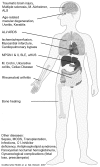New insights of an old defense system: structure, function, and clinical relevance of the complement system
- PMID: 21046060
- PMCID: PMC3060978
- DOI: 10.2119/molmed.2010.00149
New insights of an old defense system: structure, function, and clinical relevance of the complement system
Abstract
The complement system was discovered a century ago as a potent defense cascade of innate immunity. After its first description, continuous experimental and clinical research was performed, and three canonical pathways of activation were established. Upon activation by traumatic or surgical tissue damage, complement reveals beneficial functions of pathogen and danger defense by sensing and clearing injured cells. However, the latest research efforts have provided a more distinct insight into the complement system and its clinical subsequences. Complement has been shown to play a significant role in the pathogenesis of various inflammatory processes such as sepsis, multiorgan dysfunction, ischemia/reperfusion, cardiovascular diseases and many others. The three well-known activation pathways of the complement system have been challenged by newer findings that demonstrate direct production of central complement effectors (for example, C5a) by serine proteases of the coagulation cascade. In particular, thrombin is capable of producing C5a, which not only plays a decisive role on pathogens and infected/damaged tissues, but also acts systemically. In the case of uncontrolled complement activation, "friendly fire" is generated, resulting in the destruction of healthy host tissue. Therefore, the traditional research that focuses on a mainly positive-acting cascade has now shifted to the negative effects and how tissue damage originated by the activation of the complement can be contained. In a translational approach including structure-function relations of this ancient defense system, this review provides new insights of complement-mediated clinical relevant diseases and the development of complement modulation strategies and current research aspects.
Figures





References
-
- Bordet J. Les leukocytes et les proprietes actives du serum chez les vaccines [in French] Ann Inst Pasteur. 1895;9:462–506.
-
- Bordet J. Sur l’agglutination et la dissolution des globules rouge par le sérum d’animaux injecteies de sang defibiné [in French] Ann. Inst. Pasteur. 1898;12:688.
-
- Ehrlich P, Morgenroth J. Zur Theorie der Lysenwirkung [in German] Berlin Klin. Wchsr. 1899;36:6.
-
- Nuttall G. Experimente über die bacterien-feindliche Einflüsse des tierischen Körpers [in German] Z. Hyg. Infec.ionskir. 1888;4:353.
-
- Pillemer L, et al. The properdin system and immunity. I. Demonstration and isolation of a new serum protein, properdin, and its role in immune phenomena. Science. 1954;120:279–85. - PubMed
Publication types
MeSH terms
Substances
LinkOut - more resources
Full Text Sources
Other Literature Sources

